Ditapis dengan
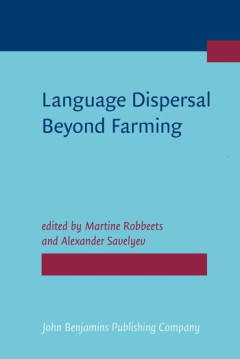
Language dispersal beyond farming
Why do some languages wither and die, while others prosper and spread? Around the turn of the millennium a number of archaeologists such as Colin Renfrew and Peter Bellwood made the controversial claim that many of the world’s major language families owe their dispersal to the adoption of agriculture by their early speakers. In this volume, their proposal is reassessed by linguists, investiga…
- Edisi
- -
- ISBN/ISSN
- 9789027264640
- Deskripsi Fisik
- xiii, 324p. : ill.
- Judul Seri
- -
- No. Panggil
- 417.7 LAN l

Dictionary of the British English Spelling System
This book will tell all you need to know about British English spelling. It's a referente work intended for anyone interested in the English language, especially those who teach it, whatever the age or mother tongue of their students. It will be particularly useful to those wishing to produce well-designed materials for teaching initial literacy via phonics, for teaching English as a foreign or…
- Edisi
- -
- ISBN/ISSN
- 9782821876279
- Deskripsi Fisik
- XXX, 492 p.
- Judul Seri
- -
- No. Panggil
- 421.52 BRO d
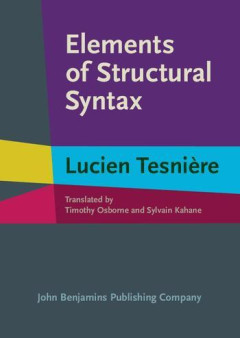
Elements of structural syntax
This volume is now finally available in English, sixty years after the death of its author, Lucien Tesnière. It has been translated from the French original into German, Spanish, Italian, and Russian, and now at long last into English as well. The volume contains a comprehensive approach to the syntax of natural languages, an approach that is foundational for an entire stream in the modern stu…
- Edisi
- -
- ISBN/ISSN
- 9789027212122
- Deskripsi Fisik
- lxxxii, 698p. : ill.
- Judul Seri
- -
- No. Panggil
- 415 TES e
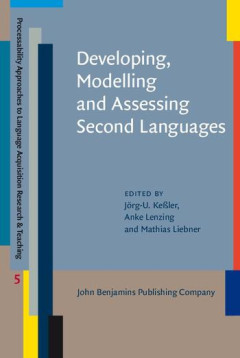
Developing, modelling and assessing second languages
This edited volume brings together the work of a number of researchers working in the framework of Processability Theory (PT), a psycholinguistic theory of second language acquisition (SLA) (Pienemann 1998; 2005). The aim of the volume is two-fold: It engages with current issues in both theory development and theory application and focuses on theoretical developments within the framework of PT …
- Edisi
- -
- ISBN/ISSN
- 9789027267191
- Deskripsi Fisik
- xviii, 244p. : ill.
- Judul Seri
- -
- No. Panggil
- 401.93 DEV d

Cyberpragmatics :internet-mediated communication in context
Cyberpragmatics is an analysis of Internet-mediated communication from the perspective of cognitive pragmatics. It addresses a whole range of interactions that can be found on the Net: the web page, chat rooms, instant messaging, social networking sites, 3D virtual worlds, blogs, videoconference, e-mail, Twitter, etc. Of special interest is the role of intentions and the quality of interpretati…
- Edisi
- -
- ISBN/ISSN
- 9789027256195
- Deskripsi Fisik
- xic, 353p. : ill.
- Judul Seri
- -
- No. Panggil
- 401.450285 YUS c

Patterns of change in 18th-century English :a sociolinguistic approach
Eighteenth-century English is often associated with normative grammar. But to what extent did prescriptivism impact ongoing processes of linguistic change? The authors of this volume examine a variety of linguistic changes in a corpus of personal correspondence, including the auxiliary do, verbal -sand the progressive aspect, and they conclude that direct normative influence on them must have b…
- Edisi
- -
- ISBN/ISSN
- 9789027263834
- Deskripsi Fisik
- xi. 311p. : ill.
- Judul Seri
- -
- No. Panggil
- 427.009033 PAT p
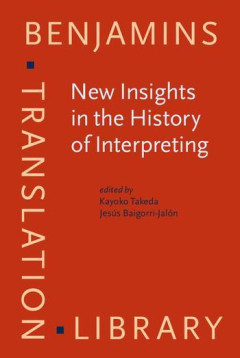
New insights in the history of interpreting
Who mediated intercultural exchanges in 9th-century East Asia or in early voyages to the Americas? Did the Soviets or the Americans invent simultaneous interpreting equipment? How did the US government train its first Chinese interpreters? Bringing together papers from an international symposium held at Rikkyo University in 2014 along with two select pieces, this volume pursues such questions i…
- Edisi
- -
- ISBN/ISSN
- 9789027258670
- Deskripsi Fisik
- xvi, 278p. : ill.
- Judul Seri
- -
- No. Panggil
- 418.0209 NEW n

Moving ourselves, moving others :motion and emotion in intersubjectivity, con…
The close relationship between motion (bodily movement) and emotion (feelings) is not an etymological coincidence. While moving ourselves, we move others; in observing others move – we are moved ourselves. The fundamentally interpersonal nature of mind and language has recently received due attention, but the key role of (e)motion in this context has remained something of a blind spot. The pr…
- Edisi
- -
- ISBN/ISSN
- 9789027241566
- Deskripsi Fisik
- viii, 492p. : ill.
- Judul Seri
- -
- No. Panggil
- 401 MOV m
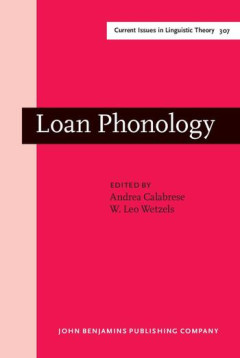
Loan phonology
For many different reasons, speakers borrow words from other languages to fill gaps in their own lexical inventory. The past ten years have been characterized by a great interest among phonologists in the issue of how the nativization of loanwords occurs. The general feeling is that loanword nativization provides a direct window for observing how acoustic cues are categorized in terms of the di…
- Edisi
- -
- ISBN/ISSN
- 9789027288967
- Deskripsi Fisik
- vii, 273p. : ill.
- Judul Seri
- -
- No. Panggil
- 414 LOA l

Theoretical comparative syntax :studies in macroparameters
Collected for the first time in a single volume, these essays and articles by Naoki Fukui form an outline of some of the most significant and formative contributions to syntactic theory. Focusing particularly on the typological differences between Eng/type language and Japanese/type languages, Fukui examines the abstract parameters that both link and divide them. Linguistic universals are consi…
- Edisi
- -
- ISBN/ISSN
- 9780203479179
- Deskripsi Fisik
- ix, 422p. : ill.
- Judul Seri
- -
- No. Panggil
- 415 FUK t
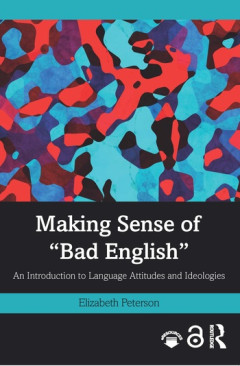
Making sense of "bad English" :an introduction to language attitudes and ideo…
Why is it that some ways of using English are considered "good" and others are considered "bad"? Why are certain forms of language termed elegant, eloquent or refined, whereas others are deemed uneducated, coarse, or inappropriate? Making Sense of "Bad English" is an accessible introduction to attitudes and ideologies towards the use of English in different settings around the world. Outlining …
- Edisi
- -
- ISBN/ISSN
- 9781138237469
- Deskripsi Fisik
- xxiv, 166p. : ill.
- Judul Seri
- -
- No. Panggil
- 427 PET m

The Roots of verbal meaning
- Edisi
- -
- ISBN/ISSN
- 9780198855781
- Deskripsi Fisik
- 288 p.; 23 cm.
- Judul Seri
- -
- No. Panggil
- 412.09 BEA r
- Edisi
- -
- ISBN/ISSN
- 9780198855781
- Deskripsi Fisik
- 288 p.; 23 cm.
- Judul Seri
- -
- No. Panggil
- 412.09 BEA r

Semantics and morphosyntactic variation:qualities and the grammar of property…
- Edisi
- -
- ISBN/ISSN
- 9780198744580
- Deskripsi Fisik
- 192 p.; 23 cm.
- Judul Seri
- -
- No. Panggil
- 415 KOO s
- Edisi
- -
- ISBN/ISSN
- 9780198744580
- Deskripsi Fisik
- 192 p.; 23 cm.
- Judul Seri
- -
- No. Panggil
- 415 KOO s

Inquisitive semantics
There is an age-old tradition in linguistics and philosophy to identify the meaning of a entence with its truth-conditions. This can be explained by the fact that linguistic and philosophical investigations are usually carried out in a logical framework that was originally designed to characterize valid reasoning. Indeed, in order to determine whether an argument is valid, it suffices to know t…
- Edisi
- -
- ISBN/ISSN
- 9780198814788
- Deskripsi Fisik
- 240 p.; 23 cm.
- Judul Seri
- -
- No. Panggil
- 412 GRO i
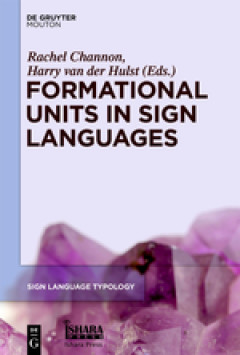
Formational units in sign languages
Sign languages and spoken languages have many fascinating differences, caused primarily by the reaction of the human mind to different modalities, but also by some important social differences. This book examines the effects of these and other differences on sign language phonology and phonetics using observation, experimentation and theory. Languages examined include Asian, Middle Eastern, Eur…
- Edisi
- -
- ISBN/ISSN
- 9781614510680
- Deskripsi Fisik
- -
- Judul Seri
- -
- No. Panggil
- 414 FOR f
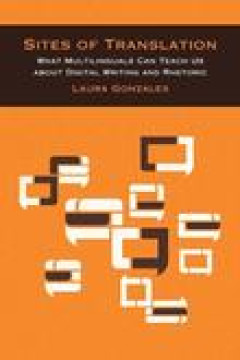
Sites of translation :what multilinguals can teach us about digital writing a…
Winner of the 2016 Sweetland Digital Rhetoric Collaborative Book Prize Sites of Translation illustrates the intricate rhetorical work that multilingual communicators engage in as they translate information for their communities. Blending ethnographic and empirical methods from multiple disciplines, Laura Gonzales provides methodological examples of how linguistic diversity can be studied in pra…
- Edisi
- -
- ISBN/ISSN
- 9780472124343
- Deskripsi Fisik
- -
- Judul Seri
- -
- No. Panggil
- 418.02 GON s

Linguistic variation, identity construction and cognition
Speakers use a variety of different linguistic resources in the construction of their identities, and they are able to do so because their mental representations of linguistic and social information are linked. While the exact nature of these representations remains unclear, there is growing evidence that they encode a great deal more phonetic detail than traditionally assumed and that the phon…
- Edisi
- -
- ISBN/ISSN
- 9783946234258
- Deskripsi Fisik
- 244 p.; 23 cm.
- Judul Seri
- -
- No. Panggil
- 414 KAT l
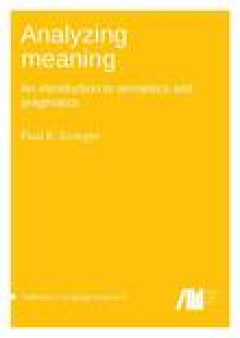
Analyzing meaning
This book provides an introduction to the study of meaning in human language, from a linguistic perspective. It covers a fairly broad range of topics, including lexical semantics, compositional semantics, and pragmatics. The chapters are organized into six units: (1) Foundational concepts; (2) Word meanings; (3) Implicature (including indirect speech acts); (4) Compositional semantics; (5) Moda…
- Edisi
- -
- ISBN/ISSN
- 9783961100354
- Deskripsi Fisik
- -
- Judul Seri
- -
- No. Panggil
- 412 KRO a

Analogical classification in formal grammar
The organization of the lexicon, and especially the relations between groups of lexemes is a strongly debated topic in linguistics. Some authors have insisted on the lack of any structure of the lexicon. In this vein, Di Sciullo & Williams (1987: 3) claim that “[t]he lexicon is like a prison – it contains only the lawless, and the only thing that its inmates have in commonis lawlessness”.…
- Edisi
- -
- ISBN/ISSN
- 9783961101870
- Deskripsi Fisik
- -
- Judul Seri
- -
- No. Panggil
- 425 NAR a

Adjective attribution
This book is the first typological study of adjective attribution marking. Its focus lies on Northern Eurasia, although it covers many more languages and presents an ontology of morphosyntactic categories relevant to noun phrase structure in general. Beside treating synchronic data, the study contributes to historical linguistics by reconstructing the origin of new types specifically in the lan…
- Edisi
- -
- ISBN/ISSN
- 9783944675657
- Deskripsi Fisik
- xiv, 301 p.; 23 cm.
- Judul Seri
- -
- No. Panggil
- 414 RIE a
 Karya Umum
Karya Umum  Filsafat
Filsafat  Agama
Agama  Ilmu-ilmu Sosial
Ilmu-ilmu Sosial  Bahasa
Bahasa  Ilmu-ilmu Murni
Ilmu-ilmu Murni  Ilmu-ilmu Terapan
Ilmu-ilmu Terapan  Kesenian, Hiburan, dan Olahraga
Kesenian, Hiburan, dan Olahraga  Kesusastraan
Kesusastraan  Geografi dan Sejarah
Geografi dan Sejarah